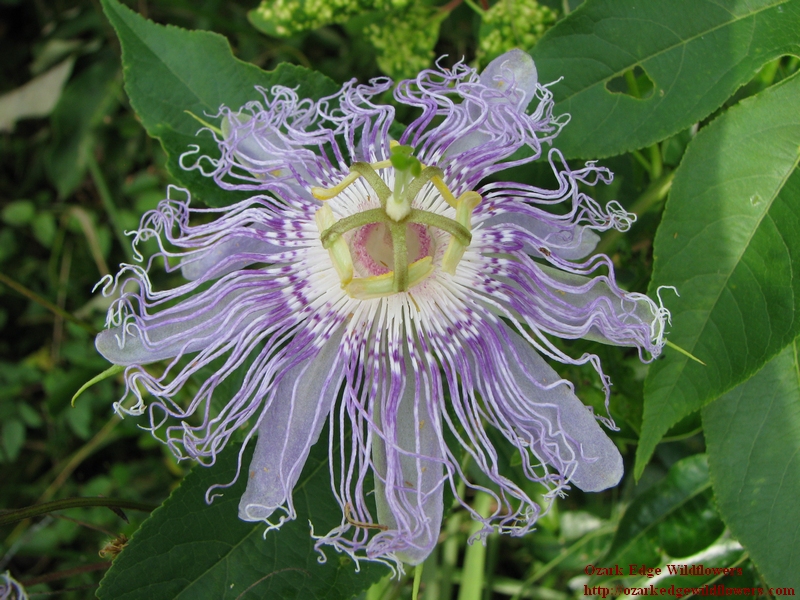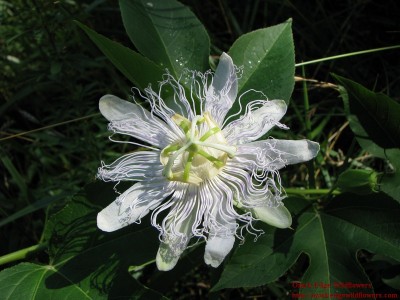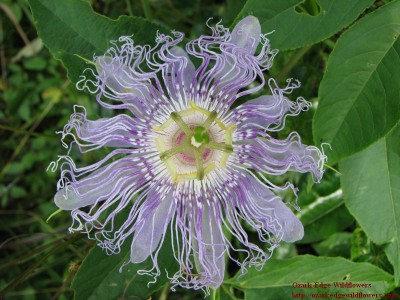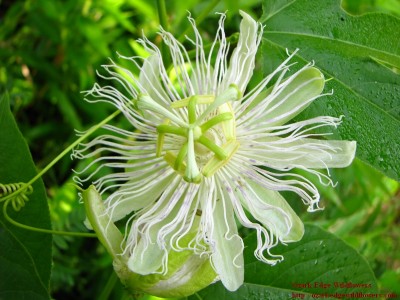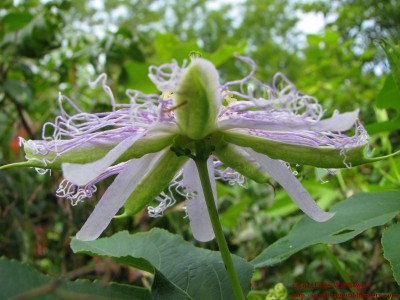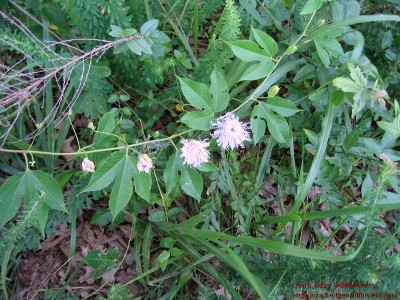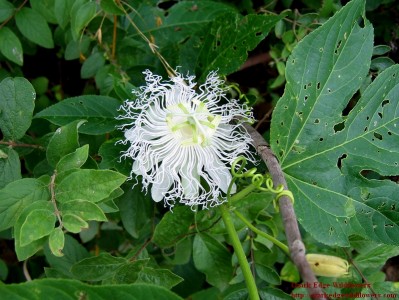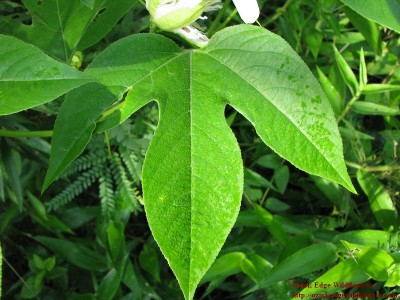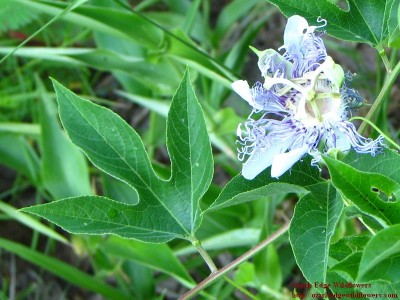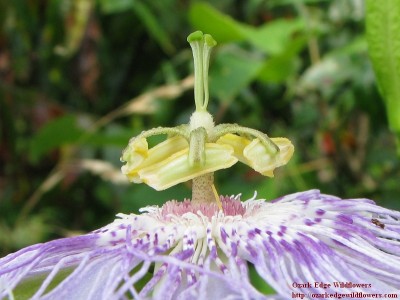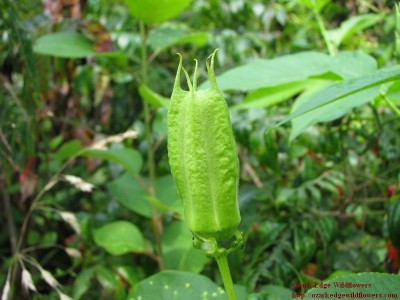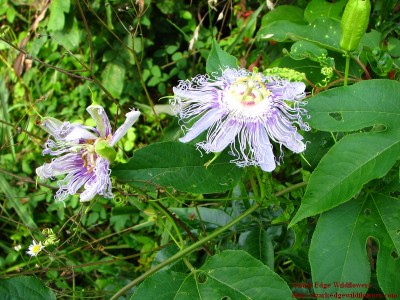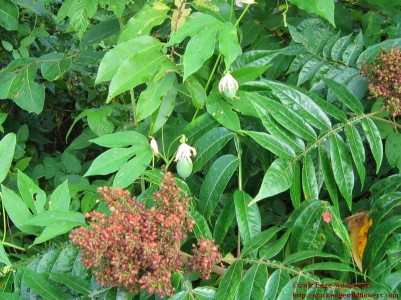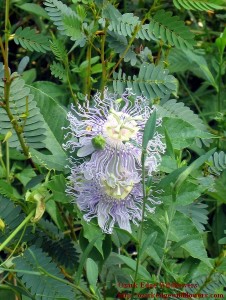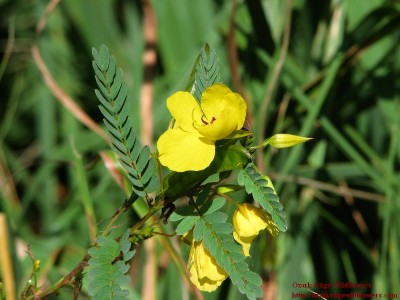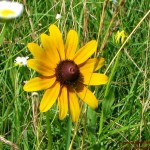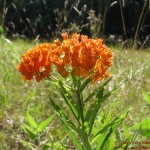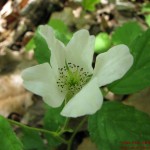I remember delighting in Passion flowers during my childhood summers on Ozarkedge, each exquisite bloom playing hide and seek in the tall grass or mingling among the fanned leaves of the sumacs. I knew just where to find them. It is comforting to find them growing in the same field all these years later.
Latin Name/Common Name- I grew up calling these unique flowers–Passion flowers and the plant- Passion Vine. The common name ‘Apricot vine’ refers to the oval, apricot sized fruit. Maypops is another name used to describe the fruit, which, when ripe makes a popping sound if you squeeze or step on it.
The Cherokee referred to the Passion Vine as “ocoee”. The root “oco” refers to the plant and “ee” describes the location. The word “ocoee” literally means the apricot vine place. Passion Vine is the state wildflower of Tennessee. The Tennessee Ocoee River and Valley are named after this plant.
The scientific name, Passiflora incarnata was given to the plant by Spanish missionaries who wove a story of the crucifixion around the parts of the flower. Incarnata is derived from the Latin word ‘carn’, meaning flesh and ‘atus’ , meaning like.
Bloom Color- The blooms are typically lavender to purple. White flowers are occasionally seen in the wild, and are available for purchase from online dealers as seed or plants labeled “alba”. Both colors are found on Ozarkedge in abundance.
White bloom “alba” in the wild on Ozarkedge
The lavender bloom is more common. The curly, fringe has alternating bands of lavender and white
Passion flowers are large, measuring about 3 inches in diameter. The fragrant flowers open and close each day. Single blossoms arise along the vine on individual stalks at the leaf axis. The bloom is actually only 5 petals–some of which split when fully open. The petals are lavender or white above and green underneath. A ring of curly fringe is layered above the petals and below the raised anthers. The fringe color mirrors the flower color, being primarily either lavender or white. With either color, it usually has bands of both white and lavender, which makes it very showy.
The corolla consists of 5 stamens with perpendicular anthers, topped by 3 styles
Sepals are green underneath
Description- Passiflora incarnata is a perennial native to the southeastern United States. The deciduous vines die to the ground each winter and re-emerge in late spring. The vines grow from 6 to 25 feet. They are frequently found trailing the ground, but may climb into surrounding vegetation. Fortunately they are weak climbers, so their flowers are at eye-level and lower.
The leaves are alternate and deeply lobed into 3 segments with pointed tips. Each leaf is smooth on the surface and soft with sparse hairs underneath.
Trailing vine growing on surrounding vegetation
Tendrils attached to sumac limb
Leaf with 3 sharply pointed lobes
Smooth stem with leaf
Passion flowers have 5 stamens with 5 large anthers and 3 styles
Bloom Time- On Ozarkedge, the first flowers begin blooming in June. Flowering persists through August.
Passion flower bud in August
Partially and fully opened flowers arising from leaf axils
The vine with fruit (covered by spent blooms) climbing on sumac
Habitat- Passiflora incarnata is found growing in unmowed fields, thickets and woodland edges. The vine trails the ground among the grasses or climbs upon low to medium high vegetation such as sumac. I’ve seen Passion vine growing in full sun, but the best looking plants are the ones that have some afternoon shade.
Beautiful Passion flower blooms mixed with foliage of Partridge pea
What’s Growing Nearby? Partridge pea (Chamaechrista fasciculata), Black-eyed susan (Rudbeckia hirta), Butterfly weed (Asclepias tuberosa), Blackberry vines (Rubus argutus) and Sumac (Rhus glabra and Rhus aromatica) are just some of the companion plants found growing alongside Passion vines.
Chamaechrista fasciculata
Rudbeckia hirta Asclepias tuberosa Rubus argutus
Endangered List- Passiflora incarnata is listed as Rare in Indiana and Threatened in Ohio.
http://plants.usda.gov/java/profile?symbol=PAIN6
Interesting Tidbits- Passiflora incarnata has had a very long relationship with humans. Archeologists have documented the use of Passiflora incarnata fruit as a food source for prehistoric Native Americans.
The medicinal properties of passion flower have been studied at least since the 18th century. It has been used to treat epilepsy, nervous disorders, and as a sleep aid. Steven Foster, of Eureka Springs, Arkansas, a specialist in medicinal and aromatic plants, has a well researched web page on the historic and current uses of Passiflora incarnata. You can link to it here- http://www.stevenfoster.com/education/monograph/pflower.html
Seed from the egg-sized fruit are eaten by bobwhite quail and songbirds. The plant is a host plant for the Gulf Fritillary butterfly. It is also a larval food for the Mexican Silverspot, Variegated Fritillary, Zebra Longwing and Isabella Tiger butterflies. The fragrant flowers are frequently visited by butterflies, bumble bees and hummingbirds in search of nectar.
